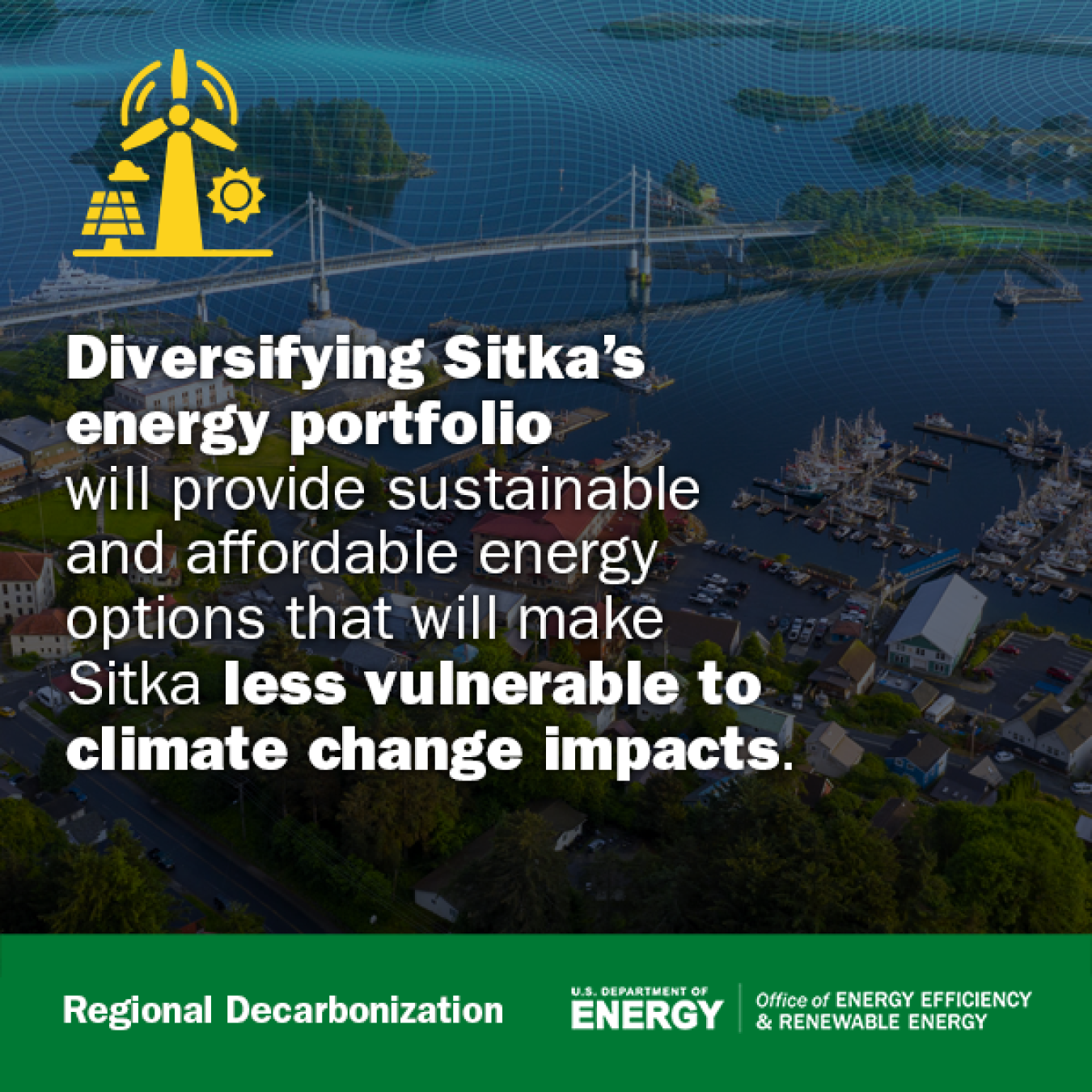Towns and organizations in Alaska illustrate how remote communities can adopt clean energy systems—and how EERE’s Energy Transitions Initiative Partnership Project can help.
Office of Energy Efficiency & Renewable Energy
August 9, 2023This article is the second in a series on DOE’s work at the state, local, and national levels to facilitate the transition to a 100% clean electricity system.
With its arctic climate, extreme transportation challenges, and a population density of roughly one person per square mile, Alaska is a reminder that different places need different approaches to transition to clean energy. Low-population communities throughout the United States face unique decarbonization challenges, and nowhere are they more evident than in Alaska’s remote towns and villages—many of which are accessible only by air or sea and have only a few hours of sunlight for half the year.

Read about EERE's other work at the state, local, and national level:
100% Clean Electricity: Transition Assistance for Utilities and Regulators
100% Clean Electricity: Planning for an Equitable Transition in Louisville, Kentucky
The U.S. Department of Energy (DOE) is committed to helping Alaskans tackle these challenges. DOE is offering targeted support to communities seeking to improve their energy resilience by transitioning from fossil fuels to 100% clean electricity, as well as making energy-efficiency upgrades. For a state that is home to critical fisheries, mineral resources, and extensive fossil-fuel infrastructure, this endeavor is as complex as it is urgent.
DOE's Energy Transitions Initiative Partnership Project (ETIPP) works with remote and island communities to transform their energy systems. These communities, which have physical features that impose strict limitations on their energy options, epitomize the importance of flexibility in planning the clean energy transition versus a one-size-fits-all approach.
In 2021, ETIPP selected five projects in Alaska for multiyear, cross-sector technical assistance, as well as in-kind support from a broad coalition of local and regional stakeholders, the U.S. national laboratories, and other DOE offices. ETIPP selected four additional Alaskan communities—McGrath, Igiugig, Nikolski, and St. George—for its 2022 funding cycle. Here are examples of ETIPP's community support work:
Sitka, Alaska, is a southeast island town of about 8,500 residents. Diversifying Sitka's energy portfolio will provide sustainable and affordable energy options for residents, while ensuring reliable power delivery that will make Sitka less vulnerable to climate change impacts like drought. To meet this goal, ETIPP helped model pathways for Sitka to add solar and wind power to its energy generation portfolio, which currently relies on seasonal lake hydropower and diesel fuel. ETIPP also helped Sitka evaluate options like ammonia and hydrogen for renewable fuel production using its seasonal surplus power. In addition to educating the community on what this pathway could look like, the ETIPP team created enduring relationships with staff at the City and Borough of Sitka that carried into a second earned ETIPP project with the community.
Wainwright, Alaska, is a village above the Arctic Circle with approximately 500 residents, most of whom are Alaska Native. The Village of Wainwright Tribe’s community center has been unused and without power for more than 10 years. ETIPP helped identify ways to reduce the center’s operating costs and diesel use while maintaining good indoor-air quality through a mixture of energy efficiency measures, renewable energy systems, and energy storage systems. These energy efficiency retrofits will enable the Tribe to use the building as a childcare facility and potentially as a backup emergency shelter.
Members of the Alaska Longline Fishermen's Association (ALFA), which is headquartered in Sitka, rely on expensive diesel fuel imports to power their vessels. ETIPP worked with the group to understand options for converting two of their fishing vessels to hybrid or fully electrified models to reduce their diesel reliance. Such measures can help make sustainable fishing operations more affordable and reduce carbon dioxide emissions, a priority for ALFA. The results of the study showed that one specific vessel could reduce diesel consumption by 60% on it's typical one-day voyage with a hybrid engine. Other vessels on three-day voyages could save 25%–61% on diesel, depending on the hybrid engine diesel/electricity ratio. Longer and more transit-intense voyages could expect 15%–25% fuel savings.
Igiugig, Alaska, is a small village located in southwestern Alaska on the south bank of the mouth of the Kvichak River and Lake Iliamna. The Igiugig community has been proactive and creative in forging their energy future, leveraging technical assistance from national laboratories to look across generation, storage, and microgrid technologies, as well as existing infrastructure to identify how to reduce their reliance on diesel fuel and generators to power their grid. The ETIPP team also worked with the Tribal Council to increase communication and community engagement for energy transition issues. These outcomes will help Igiugig move toward its goal of improving its energy self-sufficiency by using local, renewable resources and its own workforce while minimizing environmental impact and honoring its cultural identity.
Alaskan communities face energy disruptions, natural disasters, and the harmful effects of climate change while paying some of the nation's highest energy costs. Remote as they may be, these communities are on the front lines of our transition to clean electricity. So far, ETIPP technical assistance has helped nine Alaska-based partners determine how their communities can thrive under a clean electricity system, and more Alaskan towns, industries, and indigenous communities will reap the benefits in the future.
Learn more about DOE's efforts to facilitate planning for 100% clean electricity through our other funding and technical assistance programs:
- The Grid Solutions Program helps utilities, industry, and leaders overcome planning, operation, and other grid challenges.
- Communities LEAP supports low- to moderate-income and disadvantaged communities shifting away from fossil fuels.
- Clean Energy to Communities connects local governments, communities, and utilities with national lab experts for tailor-made support.
- DOE frequently issues funding opportunity announcements soliciting projects to advance clean energy technology research and development.
This success story was originally posted on August 9, 2023, and updated on June 18, 2024.

